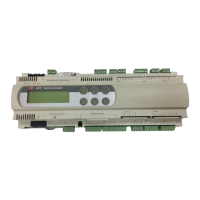5.3 Terminali privati e condivisi
Ogni scheda pCO
2
, connessa alla rete, può gestire più terminali (max 3).
La visualizzazione dei valori su di essi avviene in modo simultaneo e
non indipendente; è come avere tastiere e display connessi in parallelo.
Ogni terminale associato ad una determinata scheda, può essere
privato o condiviso. Un terminale si dice di tipo privato se visualizza in
modo esclusivo l'uscita di un unica scheda I/O. Un terminale si dice di
tipo condiviso se, in modo automatico o tramite tastiera, può essere
commutato fra più schede controllo.
Ogni pCO
2
mantiene costantemente aggiornato il display dei terminali
privati, invece se esiste un terminale condiviso, quest'ultimo, verrà
aggiornato solo se il pCO
2
in questione ne possiede il controllo in
quest'istante. Dal punto di vista logico vale la Fig. 5.3.1.
In questo esempio il terminale condiviso è associato a 4 schede I/O
ma, in questo istante, solo la 1 può visualizzare dati e ricevere i
comandi tastiera da esso. La commutazione tra schede avviene, in
successione ciclica (1→2→3→4→1....), premendo un tasto prestabi-
lito dal programma applicativo.
La commutazione può avvenire anche automaticamente su richiesta
diretta del programma. Ad esempio una scheda I/O può richiedere il
controllo del condiviso per visualizzare allarmi o, al contrario, cederne il
possesso alla successiva allo scadere di un tempo prefissato
(rotazione ciclica).
Il numero e il tipo di terminali viene stabilito in fase di
configurazione iniziale della rete. I dati relativi vengono
memorizzati nella memoria permanente di ogni singola scheda
I/O.
5.3 Private / shared terminals
Each pCO
2
board, connected to the network, can manage more than
one terminal (max 3).The display of the values on each these occurs
simultaneously and not independently from one another; it is like
having a series of keypads and dispalys connected in parallel.
Each terminal associated to a specific board can be private or shared.
A terminal is considered private if it alone displays the output of just
one I/O board. A terminal is considered shared if, either automatically
or via keypad, it can be switched between a number of control boards.
Each pCO
2
constantly updates the display of its private terminals, on
the other hand, are only updated if the pCO2 in question is currently
controlling it.This is described in the following logical diagram, Fig.
5.3.1.
In this example the shared terminal is associated to 4 I/O boards, yet
at this moment only no. 1 can display data and receive commands from
it. Switching of the boards occurs, in cyclical order
(1→2→3→4→1....), by pressing a button set by the application
program.
Switching can occur automatically on request, guided by the program.
For example, an I/O board may request control of the shared terminal
to display alarms or , alternatively, relinquish control to the next board
after a set interval (cyclical rotation).
The number and type of terminals is established during the initial
configuration of the network.The relative data is stored in the
permanent memory of each I/O board.
37
pCO
2
- cod. +030221835 rel. 3.0 - 18.02.03

